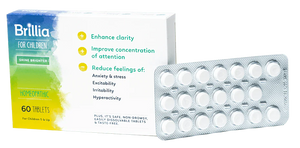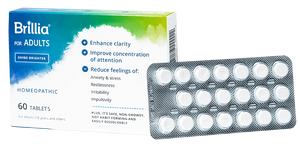Many prescription ADHD medications, including the stimulants Adderall® and Ritalin®, are notorious for causing anxiety as a secondary symptom.1 And since anxiety and ADHD often co-exist, it can feel like your symptoms are worse when starting a medication and they can persist over time.
However, though stimulant medications are often the first ones prescribed when treating ADHD, they are not the only option. There are a number of other ways to reduce ADHD symptoms without causing or exacerbating anxiety.
If you’re considering medicating your teen with ADHD, find out the best ADHD medications for kids and teens that won’t cause anxiety, what you should know about non-stimulant medications, and how Brillia can help.
Diagnosing ADHD in Your Teen
If you suspect your teen has ADHD, but you’re not sure, look for the following symptoms:
- Easily distracted
- Disorganized and forgetful
- Trouble following directions
- Self-focused behavior
- Hyperactive, prone to fidgeting
- Emotional dysregulation
- Impulsive
- Difficulty finishing tasks
While all kids and teens will experience these kinds of symptoms from time to time, when they occur frequently and start to interfere with their schoolwork and relationships, ADHD may be the culprit.
How to Help: Understanding Causes, Symptoms, Treatments
No two teens experience ADHD the same. While a teen boy may experience more external symptoms like fidgeting or blurting, a teen girl’s symptoms might be internalized, such as daydreaming or racing thoughts. If they feel like they’re head is always in the clouds, they likely have inattentive ADHD. If they’re full of energy and always on the edge of their seat, they probably have hyperactive ADHD. Even more confusing, many teens with ADHD experience hyperfocus, in which they become so absorbed in an activity that they lose interest in everything else around them. This might seem like the direct opposite of a condition in which lack of focus is a hallmark trait. But hyperfocus is extremely common, affecting around 78 percent of people with ADHD.2
According to the CDC, about 9.4 percent of children in the U.S. between the ages of 2 and 17 have been diagnosed with ADHD, making it one of the most commonly diagnosed neurodevelopmental conditions. It is estimated 80 to 85 percent of preteens continue to experience symptoms into their adolescent years, and 60 percent of children with ADHD continue to have ADHD in adulthood.3
Though experts aren’t sure what causes ADHD, here are some theories:
- Brain anatomy: Alterations in the shape of the left temporal lobe, bilateral cuneus, and areas around the left central sulcus distinguish brains with ADHD from brains without.4
- Genetics: Studies show there is a 75-91 percent chance a parent with ADHD will pass the disorder to their children.5
- Environment: Proposed ADHD environmental risk factors include prenatal substance exposure, exposure to heavy metal and chemicals, nutritional factors, and lifestyle/psychosocial factors.
- Significant head injuries: Research indicates that children who experience serious head injuries are more likely to develop ADHD, though their symptoms may not develop for up to a decade later.7
What is the Best ADHD Treatment for Teens?
The two most common ways to treat ADHD in teens are behavioral therapy and medication. And though an estimated 62 percent of kids take medication for their symptoms, only 47 percent receive behavioral treatment.8 This may include seeing a therapist, parent training, interventions in the classroom, and healthy lifestyle modifications like optimizing nutrition, getting better sleep, controlling screen time, and practicing mindfulness.
When it comes to medication, you might already be familiar with stimulants like Adderall and Ritalin, but there are also a number of non-stimulant prescription medications that are becoming just as popular, especially if your teen does not respond to stimulant drugs or the side effects are too intense. But this does not mean they are free from side effects.
Non-stimulant Prescription ADHD Medication Overview
Like stimulant drugs, non-stimulant ADHD meds target brain chemicals like norepinephrine or dopamine to control symptoms of ADHD. But, unlike stimulant drugs, non-stimulants are typically dosed for daily use. This means that some individuals take stimulant drugs as needed, but non-stimulant drugs stop working if they are stopped at any time.
Though non-stimulant drugs are often taken to avoid side effects caused by stimulant drugs, they still carry their own side effects. Here are some of the most common non-stimulants and their reported side effects:
- Strattera®: Abdominal pain, nausea, and drowsiness
- Kapvay®: Dizziness, lightheadedness, and dry mouth
- Wellbutrin®: Headaches, weight loss, and insomnia
- Qelbree®: Increase in blood pressure, fatigue, loss of appetite
How Brillia Can Help
An alternative to popular stimulant and non-stimulant ADHD medications, Brillia is a non-prescription homeopathic medication for kids and teens aged 5-18. Brillia helps to reduce ADHD symptoms like hyperactivity, inattention, restlessness, irritability, and even anxiety.
Free from harsh, synthetic chemicals and harmful side effects, Brillia’s active ingredient consists of antibodies to the S100B protein, a crucial regulator of many different intracellular and extracellular brain processes. Almost all mental and neurological diseases (as well as temporal stress-induced conditions) are accompanied by a disturbance of these processes and Brillia efficiently balances brain chemicals for a more positive, focused mood while normalizing the same neurotransmitters targeted by prescription ADHD meds: serotonin, norepinephrine, and dopamine.
Unlike prescription drugs, which are associated with a number of harmful side effects we mentioned above, Brillia will not cause drowsiness, headaches, dizziness, weight loss, or mask the personality in any way. The medication is also free from contraindications, which means you can add it to your regimen even if you are already taking other medications or supplements.
In fact, some people take Brillia to clear up secondary symptoms caused by their current prescription medications, like anxiety, which is a common secondary side effect of stimulant medications. Brillia can also be used in lieu of increasing your dosage of these other drugs to avoid exacerbating any symptoms with a higher dose.
At Brillia, we see the value in prescription medications and know that they are helpful for many. But we also prefer to see these medications as a last resort after other gentler routes have been explored. After all, some individuals report that side effects like anxiety eventually go away after their body adjusts to taking prescription medication. But, for others, these side effects persist, making other types of treatment like Brillia more appealing.
Find out more about how Brillia works and why we promote healthy lifestyle habits as part of our holistic approach in the 5 Pillars.
 A whole bunch of support right in your inbox.
A whole bunch of support right in your inbox.







